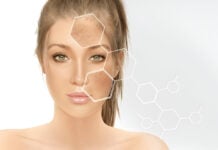In today’s digital age, exposure to screens has become part-and-parcel of most people’s lives: This leads one to wonder how new technologies affect the skin. Blue light, otherwise termed as high-energy visible (HEV) light, comes from devices like smartphones, tablets, and computers, as well as LED screens. This visibility makes the consequences on the eye and sleep easily studied and documented. However, the latest on blue light indicates that continuous exposure could damage the skin, cause premature aging, and lead to skin hyperpigmentation. This article examines the effects of blue light on the skin and its mechanisms of skin damage alongside appropriate measures to protect against it.
Understanding Blue Light and Its Sources
The blue light is a section of the visible spectrum with wavelengths of 400 to 500 nm. Contrary to ultraviolet radiation that has been studied widely for its harmful impacts on the skin, blue light crosses the epidermis and penetrates deep into the dermis with the possible induction of oxidative stress and skin cell damage (Oplas et al., 2021). Among the major sources of blue light are:
- Sunlight: Although nature is responsible for the highest potential levels of blue light exposure, hence its contribution to daily skin exposure.
- Using Electronic Devices: Prolonged exposure to screens from digital devices constitutes a great part of blue light exposure.
Artificial Lighting: LED lights and fluorescent lamps that are used in homes and offices naturally emit blue light, which adds to the overall blue light exposure.
Effects of Blue Light on Skin Health
Studies recently revealed that blue light exposure causes adverse effects on human skin, such as:
- Oxidative stress and accelerated aging: Blue light also generates reactive oxygen species (ROS) that create damage to structures in the cells, break down collagen, and accelerate aging in skin (Huang et al., 2020). All these processes cause wrinkles, lack of elasticity, and a dull complexion.
- Hyper pigmentation Uneven Skin Tone: The exposure to blue light stimulates melanogenesis, increasing the synthesis of melanin (Sami et al., 2022). Final results are with stubborn hyperpigmentation and dark spots even after exposure to sun.
- Inflammation and Altered Skin Barrier: Continuous exposure may activate the inflammation pathway for chronic blue light exposure, thus weakening the skin barrier against pollutants from the environment or irritants, rendering it more susceptible to damaging conditions such as acne and eczema (Kim et al., 2021).
Protective Measures Against Blue Light Damage
With the potential skin risks posed by blue light, protective measures must be taken. Several means help reduce the effect of blue light on skin health.
- Topical Antioxidants: Antioxidants help neutralize the oxidative stress resulting from blue light. Some of the useful antioxidants are:
Vitamin C and E: They protect against ROS damage and help in collagen production.
Niacinamide: It possesses anti-inflammatory and skin-brightening properties, helping to reduce hyperpigmentation by blue light.
Green Tea Extract: It contains polyphenols that protect against oxidative stress and inflammation (Huang et al., 2020).
- Broad-Spectrum Sunscreen with Blue Light Protection: Presently, a whole range of sunscreens has embedded blue light-blocking ingredients.
Iron Oxides: These components are in tinted sunscreens and block the hyperpigmentation induced by blue light.
Zinc Oxide and Titanium Dioxide: These ingredients, which are physical blockers of UV, partly block blue light as well (Kim et al., 2021).
- Screen Filters and Digital Device Adjustments:
For one, using blue light blocking screen protectors for your smartphones, tablets, and personal computers will directly protect you from blue light.
Second, keep “Night Mode” or “Blue Light Filter” settings on your devices active to reduce blue light emission further.
- Healthy Skincare Routine:
Regular cleansing and moisturizing are key to maintaining a solid body defense.
Peptides and ceramides are besides intervening in the liveliness of any skin exposed to blue light and contribute to tissue repair.
- Dietary Protection:
Eating antioxidant-rich foods such as berries, nuts, and leafy greens provides internal defense mechanisms from oxidative stress, and thus consuming them regularly adds to the protective mechanism of your body.
Omega-3 fatty acids and polyphenols from green tea and dark chocolate provide another boon to skin protection (Oplas et al., 2021).
Future Research and Considerations
The long-term effects of blue light have yet to be revealed, but its impact is gaining importance in today’s society. Most studies currently being conducted use laboratory models mimicking the effects of blue light; however, real-world exposure may vary significantly from what is determined by in vitro models. Dermatologists recommend protection in the approach of precaution for anyone who already has a history of existing skin problems such as hyperpigmentation or premature aging.
Awareness about the impact of blue light on skin health is now coming into public consciousness due to the increasing penetration of the digital media into our everyday lives. Blue light may cause oxidative stress, induce premature aging, and lead to hyperpigmentation. However, antioxidants, broad-spectrum protection such as sunscreen, screen filters, and a good diet may be protective measures against blue light. With burgeoning research, blue light protection will have to become an integrated aspect of contemporary skin health maintenance.
References
- Huang, Y., Song, S., & Ke, H. (2020). The impact of high-energy visible light on skin aging and protective strategies. Journal of Dermatological Science, 98(4), 254-267. https://doi.org/10.1016/j.jds.2020.05.006
- Kim, M., Choi, S., & Kim, H. (2021). Blue light exposure and its role in oxidative stress-related skin damage: Current evidence and protective approaches. International Journal of Dermatology, 60(3), 295-310. https://doi.org/10.1111/ijd.15472
- Oplas, T., Fernandez, C., & Lopez, G. (2021). Digital device use and its correlation with dermatological concerns: A systematic review. Clinical Dermatology Reports, 12(1), 102-118. https://doi.org/10.1016/j.clinderm.2021.06.009
- Sami, N., Patil, S., & Almutairi, R. (2022). The role of blue light in hyperpigmentation and potential preventive measures. Journal of Cosmetic Dermatology, 21(5), 867-880. https://doi.org/10.1111/jocd.14579












